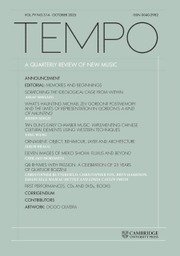No CrossRef data available.
Article contents
Abstract
The radical expansion of the written score as art object in late-twentieth and twenty-first-century music resulted in a rapid porting of extramusical objects into music’s textual realm, including a wide array of linguistic graphemes newly treated as musical material. This article suggests that the modern compositional use of scored parentheses, although rarely undertaken for identical aesthetic or formal ends, nevertheless always involves the generation of a virtual site for intimacy between irreconcilable bodies. Parentheses radically reveal the fragile contingencies of fallible musical embodiment: every– thing, every language, every intention, every body as foreign to everything else and yet nothing as foreign at all. Musical parentheses are the privileged site where the I knows that ‘I am not you’, that ‘you are not I’, that ‘you I do not know you I do not know’ – which is to say: they will reappear by the end as love.
Information
- Type
- RESEARCH ARTICLE
- Information
- Copyright
- © The Author(s), 2025. Published by Cambridge University Press.
References
1 Andrew Marvell, The Complete Poems, ed. Elizabeth Story Donno (London: Penguin Random House, 1996), pp. 49–50.
2 Giorgio Agamben, Means Without End: Notes on Politics, trans. Vincenzo Binetti and Cesare Casarino (Minneapolis: University of Minnesota Press, 2000).
3 Hélène Cixous, ‘What Is It O’clock? Or The Door (We Never Enter)’, trans. Catherine A. F. MacGillivray, in Stigmata: Escaping Texts, 1st ed. (London: Routledge, 1998), p. 85.
4 George Puttenham, The Arte of English Poesie, (London: Richard Field, 1598), pp. 140–141.
5 Salvatore Sciarrino, Berceuse (Milan: Casa Ricordi, 1970).
6 Hélène Cixous, The Book of Promethea, trans. Betsy Wing (Lincoln: University of Nebraska Press, 1991), p. 65.
7 Evan Johnson, ground (self-published, 2010), iii. Copy provided by the composer.
8 Eugenie Brinkema, Life-Destroying Diagrams (Durham: Duke University Press, 2021), p. 13.
9 Eugenie Brinkema and Evan Johnson, ‘Critique of Silence’, in differences: A Journal of Feminist Cultural Studies 22, nos. 2 and 3 (2011), p. 228.
10 Timothy McCormack, yours in the process of being absorbed (self-published, 2023).
11 Brinkema, Life-Destroying Diagrams, p. 104. The embedded quote belongs to Jean-Luc Nancy, ‘Image and Violence’, in The Ground of the Image, trans. Jeff Fort (New York: Fordham University Press, 2005), p. 15.
12 Ibid., p. 336.


